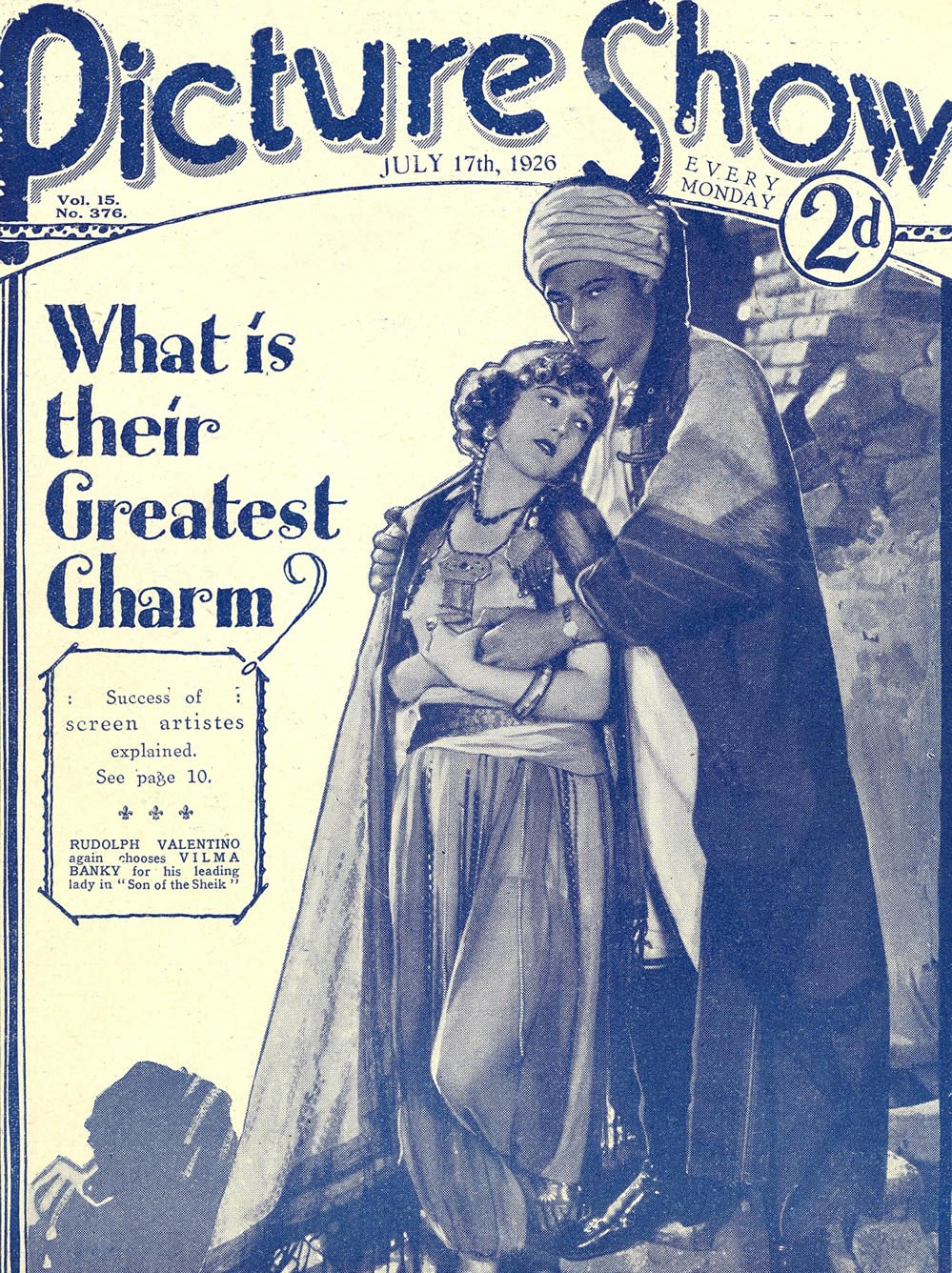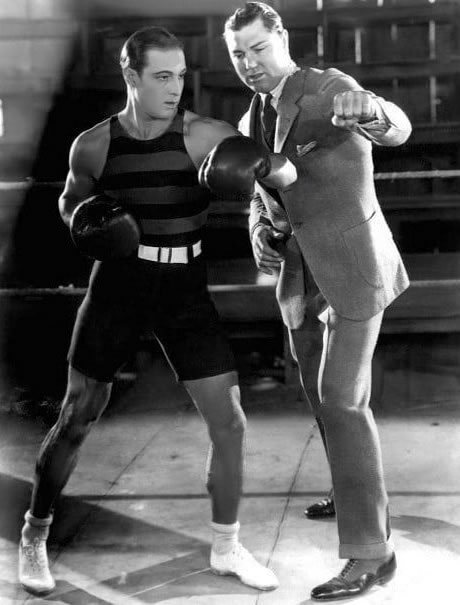‘He was the most virile and masculine of men; the women were like flies around the honeypot - he could never shake them off. What a lovely, lucky guy.’
The world’s first great screen lover whose tragic death brought scenes of mass hysteria to his star struck fans Shaun Anthony looks back this life and times
When he died in 1926, women threw themselves on his rose- decked bier as it paraded through the streets of New York, and there was mass hysteria throughout the country. Truly the first star to rise to such dizzy heights of fame and adoration, Rudolph Valentino (or the Latin Lover as he was known) was the greatest icon to come out of the silent film era.
Best known for creeping around deserts in billowing robes and black eye-liner in ‘The Sheik’ or as the tango dancing tragic figure of Julio in ‘The Four Horsemen of the Apocalypse’, Valentino’s untimely death at the age of 31 ensured him a place in cinematic folklore, he may not have had if he had lived.
Born in Italy in 1895, Rodolfo Alfonso Raffaello Piero Filiberto Gugliemi was a troublesome child, who over-indulged by his mother, did badly at school, and as a result did not get on with his father, who didn’t approve of his spoilt son. He had many childhood girlfriends and a troubled romance with a chorus girl in Paris during his teenage years. Eventually gaining a degree from agricultural college, but unable to find a job, the young Rodolpho immigrated to America in 1913 at the age of 18.
After working as a waiter for a time, because of his good looks and lithe body, Rodolpho got a job as a ticket taxi dancer in Maxim’s night club.
Maxims was the place where the rich and famous liked to be seen and Rodolpho was soon adopted by a wealthy Chilean heiress, Blaca de Saulles, although it was said that the pair were only friends; her estranged husband would later have Rodolpho arrested on vice charges. He got into major trouble pining over the married Blanca de Saulles and , when Blanca then shot her husband, Rodolpho sick of the adverse publicity decided to leave New York, joining a travelling musical heading towards the west coast.
On arrival in Los Angeles, Rodolpho continued to dance, while attempting to break into film.
In California he married Jean Acker, who was a lesbian (caught in a very powerful love triangle she seen Valentino as her way safely out of it). She locked Rudolph out of her bedroom on her wedding night. Rudolf could not understand what he had done to offend her and wrote her many love letters pleading for her to forgive him and love him as his wife.
It seems by this letters he did not know she was a lesbian, or the concept was lost on him until their separation. He was soon getting bit parts in movies, but was mostly, because of his dark looks and smouldering eyes, cast as the villain, something that would only change in 1919, when screen-writer June Mathis spotted him in ‘The Eyes of Youth’ and decided she he would be perfect for her next film, ‘The Four Horsemen of the Apocalypse, which she was writing for Metro Pictures.
Released in 1921 the film was a massive success (making a million at the box office – the first time such a sum had been reached) as well as being highly esteemed by critics, however studio bosses seemed loathe to admit that Valentino was now a huge star and continued to give him small parts in ‘B’ movies. It was during one of those –‘Uncharted Seas’ that Valentino (who had various names before settling with the one that suited him best) met second wife, Natacha Rambova, with whom he also worked on ‘Camille’ before quitting Metro and joining Famous Players-Lasky.
Marrying in Mexico in 1922, Valentino then faced bigamy charges when it emerged he had not been divorced a full year at the time of his marriage. He and Rambova were forced to live separately until they could legally re-marry in 1923; many people found Rambova controlling and Valentino fell out with a lot of his old friends during their relationship – their divorce in 1925 was a bitter one and there were no children.
It has been suggested that Valentino was never the ladies man he was painted in the media, and his foppish image, with pomaded hair and eyeliner certainly didn’t help the rumours. These rumours made Valentino extremely unhappy and he challenged the journalist who wrote the attack to a boxing match, which he went on to win. Jack Dempsey who trained him to box said later of the actor: ‘He was the most virile and masculine of men; the women were like flies around the honeypot - he could never shake them off. What a lovely, lucky guy.’
Valentino was much more than just a pretty face. Fascinated by every aspect of film-making, studying directors and eventually forming a production company, Rudolph Valentino Productions in 1925. He was also sensitive, and cultured and, when asked if his love interest in ‘The Sheik’ would have fallen for a savage, he replied that ‘people are not savages because they have dark skins; the Arabian civilisation is one of the oldest in the world and the Arabs are dignified and keen-brained.’
After ‘The Young Rajah’ Valentino, unhappy with his contract and his low wages decided to leave Players Lasky. The studio retaliated by barring him from acting for anyone else, but as he was allowed seek other kinds of employment, in 1922 Valentino embarked on a tour of America, as spokesperson for Mineralava beauty products.
His return to the screen was for Ritz-Carlton Pictures (through Players-Lasky) and Valentino managed to secure $7,500 a week wage as well as creative control; the thing he had sought all along. His first film under his new contract was ‘Monsieur Beaucaire’ in 1924, but American audiences didn’t like it and it did badly at the box office. His next film, ‘The Sainted Devil’ was also a flop.
Whether Valentino’s star was on the wane or not, United Artists were keen to snap him up, and once his contract of four films with Ritz-Carlton was seen through he joined UA; this time a generous $10,000 a week for three films a year and a percentage of profits. Filming ‘The Eagle’ he and Rambova split and it was rumoured that he and his co-star Vilma Bánky had an affair on set. While Valentino travelled to London and Paris, living it up in splendid luxury, Rambova divorced him.
His next film was ‘The Son of the Sheik’ was shot in early 1926. Despite his hating the sheik image, Valentino was forced to make it as he was short of money, and it opened to tumultuous fanfare in July of that year. He took on filming "Son of the Sheik" despite the fact he was having severe stomach pains. These pains were around as early as that summer, but he had probably been suffering for a while. June Mathis, Joseph Schenck, Norma Talmadge, and a whole slew of his friends all advised him to see a doctor, but Rudy was opposed, as he did not like doctors.
While in New York for the premiere of Son of the Sheik he took severely ill on August 15th. He was unable to eat, had severe stomach pain, and his color was bad. He was examined and moved to the Polyclinic Hospital where it was determined he had suffered from gastric ulcers.
He was operated on and daily bulletins were given out to the media, as the whole world seemed to be watching. On August 18th the doctors assured everyone that Rudy would be fine, both Rudy and George Ullman (his manager and friend who was with him the entire time) thought he would be well in no time. In fact not too long after Rudy asked to be moved back to his hotel, with nurses.
The doctors refused. On August 21st he insisted he felt great, he couldn't even feel the incision anymore...which unfortunately was a sign of infection. The infection spread and pleurisy (swelling of the lung lining) set in making it hard for him to breathe. Joseph and Norma came to visit, and had trouble watching him as he could barely talk between gasps.
He was in and out of consciousness well into August 23rd. He became delirious, believing he and George had been lost in the woods. He also still believed he would get better, telling the doctor they would go fishing soon like he promised. Sadly he lapsed into a coma and died on the 23rd of infection from the surgery. This was before antibiotics, before penicillin. This was shortly after an era where Doctors wore their own street clothes and didn't wash their hands when performing operations. Sadly several silent stars died from things now treatable, but at the time it was quite common.
An estimated 100,000 people (mostly women) lined the streets for his cortege,
and actress Pola Negri, who claimed she was his fiancée collapsed in hysterics over his coffin. After a second funeral in California, Valentino was placed in the crypt of his good friend June Mathis and the pair still rest there today, side by side. The first truly big star, he died before he was able to realise his own dreams, dissatisfied and ashamed of the caricature he had become.
In the 2 years following his death some 32 women claimed to be carrying his child, even when the timeline did not quite fit.



Sites linking to this page have chosen to adopt this Privacy Policy as their own. This means: they agree to abide by the principles laid out below.
In common with other websites, log files are stored on the web server saving details such as the visitor's IP address, browser type, referring page and time of visit.
Cookies may be used to remember visitor preferences when interacting with the website. Where registration is required, the visitor's email and a username will be stored on the server.
The information is used to enhance the visitor's experience when using the website to display personalised content and possibly advertising.
Email addresses will not be sold, rented or leased to 3rd parties. Email may be sent to inform you of news of our services or offers by us or our affiliates.
If you have subscribed to one of our services, you may unsubscribe by following the instructions which were included in the email that you received.
You can block cookies via your browser settings but this may prevent you from accessing certain features of the website.
Cookies are small digital signature files that are stored by your web browser that allow your preferences to be recorded when visiting the website. Cookies are used by most websites to record visitor preferences. Also they may be used to track your return visits to the website.
Like all sites, we use 3rd party tools to help us run the website. They are used not to track you but to track info like the visitors numbers on the site over a given period, to allow you to interact with the social-media widget and to allow us to login into this web based CMS (Content Management System).